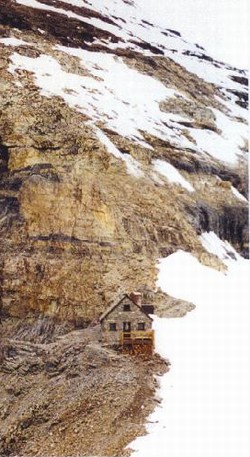
Photo: Abbot Pass (courtesy Lyle Miller)
Abbot Pass
- 2922 m (9587ft)
- Naming History
- Peaks and Rivers
Province: Alberta/BC
Park: Banff/Yoho
Named by:
Named for: Abbot, Philip S. (A member of the Appalachian Mountain Club, Philip Abbot fell and was killed on 3 August, 1896 while attempting the first ascent of Mount Lefroy which rises to the south of the pass.)
Mountain (SE): Mount Lefroy
Headwaters (NE): Louise Creek
Headwaters (SW): Oesa Creek
ABBOT PASS
Abbot Pass was first reached by Samuel Allen and Yule Carryer. They ascended the scree gully from Lake Oesa (BC) in 1894. (Gest)
The steep western slopes of Mount Lefroy above what is now known as Abbot Pass were the scene of the first fatal climbing accident in the Canadian Rockies. Philip Abbot had considerable climbing experience, having climbed in the Alps. In 1895, together with Charles Fay, Charles Thompson, and others, he completed the first ascent of nearby Mount Hector from which Abbot seemed to develop an obsession with Mount Lefroy. Fay wrote, _Ûit seemed as though he dreamed of Lefroy by night and planned campaigns against it in the leisure moments of his active professional life.î
The following year, 1896, Abbott, together with Fay, Thompson, and George Little, attempted Lefroy on August 3rd. As they ascended the final 600 metres the steep ice slopes and poor rock were a concern, Fay later writing, _Caution governed every movement.î
After leaving the ice to climb on rock, Abbot, who had been leading, asked the others to unrope and wait so that he could advance more easily. Fay described what happened next, _A moment later Little, whose attention was for the moment diverted to another portion of the crag, was conscious that something had fallen swiftly past him, and knew only too well what it must be. Thompson and I, standing at the base of the cliff, saw our dear friend falling backward and head-foremost, saw him strike the upper margin of the ice slope within fifteen feet of us, turn completely over and instantly begin rolling down its steep incline.î
After a careful descent, Fay, Thompson, and Little reached their friend who died shortly thereafter.
Abbot's father asked Professor Fay to make arrangements for a "Memorial Climb" the following year. The Alpine Club of London was asked to participate and
Norman Collie and H.B. Dixon, together with guide Peter Sarbach, joined Fay's party. Exactly one year after the accident the party reached the summit. After a day's rest, Collie and Sarbach led the party that made the first ascent of Mount Victoria.
The high pass that lies between Mount Lefroy and Mount Victoria was named Abbot Pass in memory of Phillip Abbot.
THE ABBOT PASS HUT
Abbot Pass lies between Mount Lefory and Mount Victoria. In the early 1920's these two peaks are popular climbs as they are today. In 1921 Edward Feuz jr. and Rudolph Aemmer drew up plans for a stone hut to be built on the pass that would serve as a base for mountaineers attempting these two mountains. Initially the government officials and the CPR were reluctant to undertake the project but when the two guides showed their idea to Basil Gardom, a construction superintendent with the railway, he was fascinated and used his influence to have the project approved by the CPR. It was built the following year in 1922.
The building was to be constructed primarily from stone near the site but the project required transporting all the other necessary building materials from Lake Louise to the pass, a 4500 foot (1372 metres) elevation gain. The "Death Trap," the narrow part of the Victoria Glacier that lay below the steep cliffs of Lefroy and Victoria, was a concern as avalanches frequently fall from the hanging glaciers above onto the glacier that descends from the pass. Horses, lightly packed, were led through the crevassed lower section of the glacier. Beyond that, loads were placed on a sled that was then hauled up to the pass by a winch. Other materials were carried up on the guides' backs. A total of about two tons of materials were hauled to the building site.
The "Death Trap" was named during the construction of the hut following an incident involving Suiss guide, Edward Feuz jr. While passing through the dangerous area, Edward and some others were swept down the glacier by an avalanche and barely esacaped with their lives. Porters who were carrying loads for the hut found Edward with only his hand sticking out of the snow and dug him out. It is said that after he regained his composure somewhat his first concern was that he had lost his pipe in the "darned avalanche." (Engler)
The hut was officially opened in the spring of 1923. Twenty members of the Appalachian Mountain Club, of which Philip Abbot had been a member, travelled from Massachusetts to honour their friend. CPR officials climbed to the pass as well.
The hut was designated a national historic site in 1997 and is currently maintained and operated by the Alpine Club of Canada. It remains a most unique structure in a very spectacular, remote location and the experience of spending a night in the stone hut will always be treasured by those fortunate enough to visit Abbot Pass.